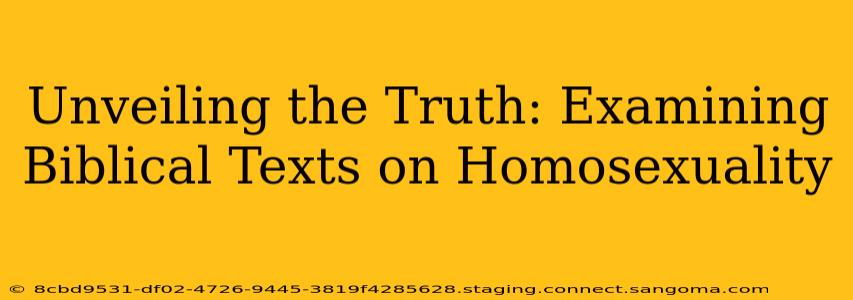The interpretation of biblical texts regarding homosexuality is a complex and often contentious issue, sparking debate among theologians, scholars, and individuals of faith for centuries. This exploration delves into the key passages frequently cited in discussions about same-sex relationships, analyzing their historical context, original language nuances, and varying interpretations to present a nuanced understanding. It's crucial to approach these texts with humility, recognizing the limitations of our understanding and the evolving nature of theological interpretation.
What are the key Bible verses used against homosexuality?
Several passages in the Old and New Testaments are often cited as condemning homosexual acts. The most frequently mentioned are Leviticus 18:22 and 20:13, 1 Corinthians 6:9-10, and 1 Timothy 1:10. However, a careful examination reveals significant complexities in understanding these verses within their original cultural and linguistic contexts. Simply quoting these verses out of context often leads to misinterpretations and overlooks crucial historical and societal factors.
What does Leviticus 18:22 and 20:13 actually say?
Leviticus 18:22 states, "You shall not lie with a male as with a woman; it is an abomination," and Leviticus 20:13 reiterates this prohibition. These verses, part of the Holiness Code, are often presented as definitive condemnations of all same-sex acts. However, the precise meaning of "lying with" (Hebrew: shakav) and the nature of the "abomination" (to'ebah) are subject to debate. The term shakav encompasses a wide range of sexual acts, not necessarily limited to penetrative intercourse. Furthermore, to'ebah is a broad term referring to things considered ritually impure or offensive within a specific cultural and religious context. Many scholars argue that these verses reflect ancient Israelite social norms and concerns about fertility and lineage within a patriarchal society, rather than a universal condemnation applicable across all times and cultures.
What about 1 Corinthians 6:9-10 and 1 Timothy 1:10?
1 Corinthians 6:9-10 lists “men who practice homosexuality” among those who will not inherit the kingdom of God. 1 Timothy 1:10 similarly mentions “men who practice homosexuality.” The Greek word used here, arsenokoitai, is not easily translated and its precise meaning is debated. Some scholars suggest it refers to temple prostitutes or pederasty (sexual relationships between older men and young boys), rather than consensual same-sex relationships between adults. The context of these passages is also significant. Paul was addressing specific moral and ethical concerns within the early Christian communities, and the interpretation of these verses must consider the socio-cultural context of first-century Corinth.
How do different Christian denominations interpret these verses?
Interpretations of these biblical texts vary considerably across different Christian denominations and theological perspectives. Some conservative denominations hold to a literal interpretation, emphasizing the condemnation of same-sex acts. Other denominations, including many mainline Protestant and Catholic churches, offer more nuanced interpretations, emphasizing the importance of love, compassion, and inclusion. They may argue that these verses should be understood within their historical context and that the overarching message of love and acceptance in the Gospels outweighs these specific prohibitions. Some scholars even suggest that the condemnation in these passages was against exploitative or cultic practices rather than loving, committed same-sex relationships.
Are there any positive portrayals of same-sex relationships in the Bible?
While explicit endorsements of same-sex relationships are absent from the Bible, some scholars point to the strong bonds of friendship and loyalty depicted in various biblical narratives as potentially reflecting aspects of same-sex love. The relationship between David and Jonathan, for example, is often cited as an example of deep affection and loyalty transcending typical societal norms. The interpretation of this relationship is, of course, debated, but it highlights the importance of considering diverse interpretations and avoiding overly simplistic readings of scripture.
Conclusion:
The debate surrounding biblical texts and homosexuality is multifaceted and calls for careful consideration of historical, linguistic, and theological contexts. There is no single, universally accepted interpretation. Approaching these texts with humility, critical thinking, and a commitment to understanding diverse perspectives is essential for a thoughtful and responsible engagement with this important topic. It’s crucial to remember that interpretations evolve as our understanding of the Bible and its historical context deepens. The focus should always be on love, compassion, and the pursuit of justice for all.

